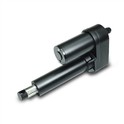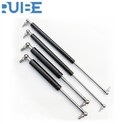As a seasoned supplier in the gas spring industry, I've witnessed firsthand the transformative impact that well - balanced gas spring - assisted mechanisms can have on various applications. From tool boxes to bonnets and furniture, gas springs play a crucial role in providing smooth operation and optimal functionality. In this blog, I'll share some valuable insights on how to adjust the balance of a gas spring - assisted mechanism.
Understanding Gas Springs
Before delving into the adjustment process, it's essential to have a basic understanding of gas springs. Gas springs are mechanical components that use compressed gas (usually nitrogen) to provide a force. They consist of a cylinder, a piston rod, and a seal. The gas inside the cylinder is compressed, and when the piston rod is pushed or pulled, the gas expands or contracts, generating a force.
The force exerted by a gas spring is determined by several factors, including the pressure of the gas inside the cylinder, the cross - sectional area of the piston rod, and the length of the stroke. Different applications require different gas spring forces to achieve the desired balance.
Applications of Gas Springs
Gas springs are widely used in a variety of industries. For instance, Gas Struts for Tool Box are designed to make it easy to open and close tool boxes. They provide a smooth and controlled motion, preventing the tool box lid from slamming shut.
Bonnet Gas Spring is another common application. In automotive and machinery, bonnet gas springs help in effortlessly lifting and holding the bonnet in an open position. This makes maintenance and inspection tasks much more convenient.
Gas Spring for Furniture is also popular. It can be used in chairs, beds, and cabinets. In chairs, gas springs allow for easy height adjustment, while in beds, they can assist in lifting the mattress for storage.
Importance of Balancing Gas Spring - Assisted Mechanisms
Balancing a gas spring - assisted mechanism is crucial for several reasons. Firstly, it ensures smooth and safe operation. An unbalanced mechanism may result in jerky movements, which can be dangerous, especially in applications like automotive bonnets or heavy - duty tool boxes.
Secondly, proper balance extends the lifespan of the gas spring and the entire mechanism. When a gas spring is over - or under - stressed due to improper balance, it may wear out more quickly, leading to frequent replacements and increased costs.
Finally, a well - balanced mechanism provides a better user experience. Whether it's a consumer using a piece of furniture or a mechanic working on a vehicle, a smoothly operating gas spring - assisted mechanism makes tasks easier and more enjoyable.
Steps to Adjust the Balance of a Gas Spring - Assisted Mechanism
Step 1: Evaluate the Current Situation
The first step is to assess the current state of the mechanism. Observe the movement of the component that the gas spring is assisting. Is it too hard to open or close? Does it move too quickly or too slowly? These observations will give you an idea of whether the gas spring force needs to be increased or decreased.
For example, if you're dealing with a tool box and the lid is difficult to open, it may indicate that the gas spring force is too low. On the other hand, if the lid slams shut too quickly, the force may be too high.
Step 2: Determine the Correct Force
Once you've evaluated the current situation, you need to determine the correct force for the gas spring. This can be done through calculations or by referring to industry standards. The force required depends on factors such as the weight of the component being moved, the distance of the movement, and the desired speed of operation.
If you're unsure about the calculations, you can also consult with our technical support team. We have extensive experience in the gas spring industry and can provide accurate recommendations based on your specific application.
Step 3: Select the Right Gas Spring
Based on the determined force, select the appropriate gas spring. Gas springs come in different sizes, stroke lengths, and force ratings. Make sure to choose a gas spring that matches the requirements of your mechanism.
When selecting a gas spring, also consider factors such as the environment in which it will operate. For example, if the mechanism is exposed to high temperatures or corrosive substances, you'll need a gas spring with appropriate material and coating to ensure durability.
Step 4: Installation and Initial Testing
Install the selected gas spring according to the manufacturer's instructions. Make sure all connections are secure and that the gas spring is properly aligned. After installation, perform an initial test of the mechanism. Open and close the component several times to check the movement.
If the movement is still not satisfactory, you may need to make further adjustments. This could involve changing the mounting position of the gas spring or adjusting the pre - load of the gas spring.
Step 5: Fine - Tuning
Fine - tuning is an important step in achieving the perfect balance. You can adjust the balance by making small changes to the gas spring's position or by using shims to change the effective length of the gas spring.
During the fine - tuning process, make sure to test the mechanism after each adjustment. This will help you determine if the change is moving the mechanism towards the desired balance.
Troubleshooting Common Issues
Even after careful adjustment, you may encounter some common issues. One common problem is gas leakage. If you notice a decrease in the gas spring's performance or visible signs of gas leakage, it may be necessary to replace the gas spring.
Another issue is noise during operation. This could be due to loose connections, worn - out components, or improper lubrication. Check all connections and components for tightness, and apply appropriate lubrication if necessary.
Contact for Purchase and Consultation
If you're in the market for high - quality gas springs or need further assistance in adjusting the balance of your gas spring - assisted mechanism, we're here to help. Our team of experts has in - depth knowledge of gas springs and can provide you with the best solutions for your specific needs.
Whether you're looking for Gas Struts for Tool Box, Bonnet Gas Spring, or Gas Spring for Furniture, we have a wide range of products to choose from. Contact us today to start a discussion about your requirements and explore how our gas springs can enhance your applications.


References
- "Gas Springs: Design, Application, and Installation" - Industry Handbook
- Technical Papers on Gas Spring Mechanics from Leading Manufacturers






